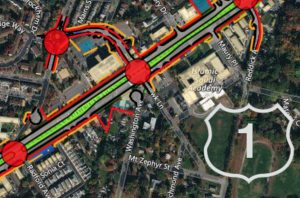 VDOT has proposed a new design for Richmond Highway (RH), between Jeff Todd Way and Sherwood Hall Lane in eastern Fairfax County. The proposal includes widening RH to 178 feet with six 11-foot car lanes and a grass median in the center that will be reserved for bus rapid transit (BRT). VDOT’s design maintains a huge amount of space for high-speed car travel which we know to be unsafe for pedestrians and bicyclists.
VDOT has proposed a new design for Richmond Highway (RH), between Jeff Todd Way and Sherwood Hall Lane in eastern Fairfax County. The proposal includes widening RH to 178 feet with six 11-foot car lanes and a grass median in the center that will be reserved for bus rapid transit (BRT). VDOT’s design maintains a huge amount of space for high-speed car travel which we know to be unsafe for pedestrians and bicyclists.
This widening project is part of a larger Fairfax County effort known as Embark Richmond Highway. Embark has grander ambitions than simply widening RH and adding BRT down the middle. Embark aspires to transform a 45 MPH suburban strip mall highway into a “Main Street” for eastern Fairfax County where people can walk, bike, shop, and enjoy parks comfortably and safely. VDOT’s design falls short of this vision.
We need you to comment on VDOT’s proposal via this survey before April 26th. The survey is focused on proposed underpasses at Little Hunting and Dogue Creeks. We support the underpasses, but the at-grade design needs critical changes to be safe for all users.
In the comment section of the survey please include these four ways that FABB believes VDOT’s design should be improved:
-
- Design for a 35 MPH Speed Limit
-
- Narrow the Lanes
-
- Two-Way Cycle Tracks Needed
-
- Ensure Safe Crossings At-Grade and With Underpasses
Here’s why we need VDOT to change the design:
Design for a 35 MPH Speed Limit. A 45-MPH speed limit is not a “Main Street” speed and will be dangerous for people who bike and walk in the RH corridor. VDOT should look at what MDOT is doing in Maryland for similar corridors – narrowing lanes and reducing speeds to 35mph (and to 25 mph in some locations). In 2018, Alexandria lowered the speed limit on Route 1 through Potomac Yard to 25 mph from 35 mph.
Narrow the Lanes. VDOT is proposing 11-foot wide vehicle lanes and a total highway width of 178 feet. VDOT should narrow the travel lanes to 10 feet and use the extra width to widen the cycle tracks and sidewalks.
Two-Way Cycle Tracks Needed. Speaking of cycle tracks, VDOT is proposing one-way protected bike lanes on both sides of RH. While FABB applauds the inclusion of separated bike paths, these need to be bi-directional cycle tracks. As proposed, the one-way bike path will require bicyclists who want to travel the “wrong way” to reach a destination on the same side of RH to cross the 178′ highway, twice! This is a design flaw that needs to be fixed! Bi-directional cycle tracks on both sides of RH will allow bicyclists to ride north or south without having to cross the widened highway.
Ensure Safe Crossings. The current highway is only 72 feet at its widest, but it has a chronic issue of people getting hit by cars when trying to cross. In fact, the same day as the VDOT design presentation, a person was hit in a crosswalk trying to cross RH at Quander Road and later died from his injuries. We know people are being killed along these types of suburban highways. FABB supports the proposed underpasses to provide pedestrians and bicyclists a safe option to cross Richmond Highway at Dogue Creek and Little Hunting Creek. VDOT must also ensure safe at-grade crossing options at the bridges, all intersections, and BRT stations.
There’s still time to let VDOT hear your views. Please comment on this project by the April 26 deadline!
